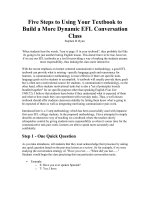Five keys to successful PoE deployment
Bạn đang xem bản rút gọn của tài liệu. Xem và tải ngay bản đầy đủ của tài liệu tại đây (126.08 KB, 2 trang )
f you were to put together a list
of the hottest technologies in today’s
networking industry, WiFi (wireless networking) and
VoIP (Voice over Internet Protocol) would be near the
top. Recently, several major corporations announced
plans for a global rollout of IP phones. By the same to-
ken, WiFi hotspots have cropped up everywhere.
In addition to being current industry buzzwords,
WiFi and VoIP also share another common attri-
bute. They both require Ethernet and power to func-
tion. In June 2003, the Institute of Electrical
and Electronics Engineers (IEEE—
www.ieee.org) released IEEE
802.3af, also known as the
Power over Ethernet (PoE)
standard, which was estab-
lished to provide a universal
way to provide power and Ethernet-based data to a re-
mote powered device over standard Ethernet cabling,
such as Category 5e or Category 6.
Before 802.3af, vendors and consumers of IP phones
were faced with two options: Provide local power
through an AC (alternating current) electrical outlet,
or use non-standards-based proprietary solutions to
provide inline powering. Both choices were equally
unappealing.
The release of 802.3af has enabled technologies such
as VoIP and WiFi, and has paved the way for literally
hundreds of new product ideas that require the com-
bination of both data and power. Examples include
radio-frequency identi cation (RFID) scanners, IP-
security cameras, alarm systems, and smart-build-
ing controls.
Planning for integration
Given the future impact PoE-based devices will have
on your business, it is important to begin planning how
to integrate PoE into your current and future network.
The IEEE standard recognizes two methods for deploy-
ing PoE in your network. The rst requires that Eth-
ernet switches inject power and data at the same time.
This approach may work well for new installations, in
which a new switch must be purchased anyway; how-
ever, it likely will require a much larger power supply
and will be more expensive than a standard Ethernet
switch. These devices are referred to
in the 802.3af standard as “endspan” devices, since the
power is injected at the end of the structured cabling
where it terminates on the Ethernet switch.
The second method involves using a dedicated power-
injecting device in between the Ethernet switch and the
remote powered device. These power-injecting devices
are known in the standard as “midspan” devices, and
work well for both new and existing installations with
non-PoE-enabled Ethernet switches.
How to ensure PoE success
When deployed correctly, PoE is safe, reliable, and cost-
effective. But because it is such a new networking tech-
nology, it is important to consider ve keys that will
ensure successful PoE deployments:
Carefully consider the devices’ capabilities and
limitations before putting them to use.
JOHN SCHMIDT is a product manager with ADC (www.adc.com).
Before deploying a midspan powering device like this one from
ADC, make sure it complies with the IEEE 802.3af Power over
Ethernet speci cations and the TIA Category cabling speci ca-
tions that apply to your cabling system.
Five keys to
successful PoE deployment
design
I
Reprinted from the February 2005 edition of CABLING INSTALLATION & MAINTENANCE
Copyright 2005 by PennWell Corporation
1. Provide sufcient power to the remote powered device.
This may sound simple, but in practice, it is difcult. The
IEEE 802.3af standard identies four possible power clas-
sications. At maximum, the powered remote device can
draw up to 12.95 watts of power. Factoring loss through
the length of the cable, this means that, at maximum, the
power-sourcing equipment must have the ability to pro-
vide 15.4 watts of power to each port. In a 24-port Eth-
ernet switch or midspan device, this means that approxi-
mately 370 watts of power must be available to supply the
necessary power to each port. For the Ethernet switches,
additional power above and beyond that required for PoE
must be available for its switching functions. With this in
mind, pay close attention to the size of the power supply
used in each device. Midspan devices should have in excess
of 370 watts available and Ethernet switches should have
signicantly more, depending on how much power their
switching functions require. A rule of thumb is to check
the power-supply size used on a non-PoE-enabled switch
and add 15.4 watts per port to determine if the power sup-
ply is large enough.
2. Connect the power source to uninterruptible and redun-
dant power. The remote devices fed by PoE typically are
mission-critical devices. For instance, an IP phone that loses
power is a lost voice circuit. Think about that for a moment.
Regardless of whether it is a traditional circuit-switched an-
alog phone or an IP phone, it is a lifeline circuit. It has to
work. You must consider how you are going to design your
network to ensure that consistent and reliable data transfer
and power are maintained to this critical device. Connect the
critical power-sourcing devices to an uninterruptible power
supply, and use devices with dual redundant power supplies
to ensure that your critical devices never lose power.
3. Deploy only IEEE 802.3af-compliant devices. Before release
of 802.3af, many companies chose to develop products to
various proprietary standards in order to provide PoE ca-
bling. Many of these devices are still being sold, even though
the standard is now released. Be sure to verify that both the
sourcing device and the powered remote device are compat-
ible with each other. If both devices list IEEE 802.3af in their
specications, you are covered. But if any of the devices you
are using do not explicitly state compliance to IEEE 802.3af,
be cautious. Carefully read the technical documentation and
contact the technical-support number to determine compat-
ibility. Failure to do so will leave you frustrated and will cost
you time and money.
4. Pay attention to cabling-performance specications. What
Category rating does your cabling infrastructure have? Prob-
ably Category 5e or 6. Now if you deploy Power over Eth-
ernet with a midspan device, how does that affect your per-
formance? Pay close attention to the manufacturer’s speci-
cations. Look for Category 5e and 6 compliance. Midspans
should be treated just like an-
other patch panel in your chan-
nel; if they are of an unkown
Category or one lower than the
rest of your cabling, you may
be signicantly disregarding
the performance of your infra-
structure. Also, remember that
per TIA standards, only four
connectors can exist between the switch or hub and the
network interface card (NIC). A midspan device should be
counted and treated as one of these connection points. Peo-
ple commonly ask how far they can run Power over Ethernet.
The answer is 100 meters from the switch or hub to the NIC,
regardless of where the power is injected. The limitation is
not the power; it’s the Ethernet cabling standards that limit
the total length of cabling to 100 meters.
5. Use the most cost-effective PoE method for your network.
The business motivation behind deploying IP-based tech-
nologies like WiFi and VoIP is to decrease networking costs.
A signicant benet of PoE is that it runs on your existing
infrastructure. If you have recently purchased or upgraded
your Ethernet switches, but they are not compliant to the
IEEE 802.3af standard, before you run out and buy all new
Ethernet switches (which you probably won’t do), and be-
fore you abandon or delay your project (which you don’t
want to do), consider using midspan devices to inject power.
These devices are economical to purchase and install rela-
tive to Ethernet switches, and they let you insert standards-
compliant PoE using your existing infrastructure, including
the existing Ethernet switch.
Know the potential and limitations
To deploy Power over Ethernet successfully, it is important to
realize both the potential and the limitations of the devices
you are putting into your network. Properly deployed Power
over Ethernet technology in your network will lead to a safe,
reliable, and economical solution for delivering consistent
and dependable power to such common networking devices
as VoIP phones and WiFi access points.
Invest the time today to learn about this new technology
and you will thank yourself tomorrow as you successfully de-
ploy your next-generation networking equipment.
Midspans should be treated just like another patch panel
in your channel; if they are of an unknown Category or one
lower than the rest of your cabling, you may be signicantly
disregarding the performance of your infrastructure.
For more information, visit www.adc.com/truenet Lit. #1325044









